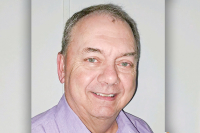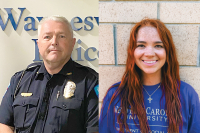Haywood County doctors doubly vested in health care venture with MedWest
A new $9.3 million surgery center in Haywood County is being financed with equity put up by 20 doctors in the community who invested capital in exchange for a real estate interest in the project.
The hospital will lease the space, outfit it with equipment and manage its operation, but won’t pay for any of the construction costs.
MedWest CEO Mike Poore said the hospital could have afforded to build the surgery center on its own if it had to, but prefers the business structure.
“We could have taken on the debt, but what’s more important is it has our physicians invested even more in the health care of our community,” Poore said.
Poore said the hospital-physician partnership makes the outpatient surgery center all the more unique.
The business arrangement marries the hospital and physician community. Now more than ever, their success is contingent on the other.
Related Items
The doctors will profit from the lease paid by the hospital. The hospital profits from the patients the doctors will rake in.
Also involved in the project is Meadows and Ohly, a development company out of Charlotte that builds medical offices and outpatient centers. The firm will act as the general partner and orchestrate the construction.
The 20 physicians who bought shares in the project as limited partners fronted nearly one third of the building’s cost, accounting for all the equity.
At first blush, the number of doctors who bought in to the outpatient center is impressive — more than 20 percent of the doctors practicing in Haywood.
But it is a fairly fool-proof and risk-free venture. As long as the hospital keeps leasing the space, they’ll get a return on their investment.
Dr. Luis Munoz, a pathologist, said for some doctors who put up money, it may have seemed like an attractive real estate investment. But for most it was out of their conviction to support health care in the community they serve.
The project didn’t exactly hinge on the financial backing of physicians.
“I could always do it with my own equity,” said Jay Bowling, vice president of Meadows and Ohly.
And the firm could have kept all the profits for itself.
“Are we leaving money on the table? Probably,” Ohly said.
But, the project is much stronger thanks to doctors’ involvement, Bowling said. And certainly less risky.
Its success is nearly guaranteed since the doctors are doubly vested: not only in their own practices but also as a real estate investor. The more business they bring in, the better surgery center does, and the more they get back on their lease.
Storied history
An outpatient surgery center has been in the works for more than a decade, but at one time was a controversial undertaking, one that looked much different than the end result today.
Five years ago, the hospital was poised to break ground on a $16.5 million expansion, financed and funded solely by the hospital. In late 2007, hospital leadership held a reception to unveil the blueprints, and even showed off upholstery samples for new waiting room sofas.
But the entire project came crashing down a few months later when the hospital lost its Medicare and Medicaid status after failing federal inspections in early 2008. Savings squirreled away to pay for the $16.5 million surgery wing were spent instead to keep the hospital afloat until it rebounded from the crisis. The leadership in place at the time has been replaced.
More than $400,000 spent on architects and plans went down the drain.
The project today looks much different than the one pursued by the older hospital leadership — both in scope and cost.
While the old project was billed as a “surgery center,” in reality it was a new wing of the hospital. The old plans simply called for a makeover of existing surgery rooms, while the majority of the project was ancillary: a new lobby and main entrance, new administrative offices and two floors of “shell” space for future expansion, for example.
While that project was shelved, the idea for an outpatient center was not.
Starting over from scratch — and without a nest egg to work with — the hospital administration and more than a dozen doctors split the cost of a $40,000 feasibility study in 2009 to reassess the project.
The result is a far different project: a standalone building on the hospital’s campus with the entire footprint dedicated to outpatient services.
New era of physician involvement
Other than its physical differences, the most marked evolution in the project is the business arrangement, namely the partnership with the doctors.
Under the old leadership, that type of investment and partnership wasn’t welcomed or allowed, Poore said.
Doctors had previously sought a seat at the table, offering to partner with the hospital and help finance the surgery center.
But the former hospital CEO wanted “complete and total control” and shut the doctors out, said Dr. Luis Munoz, a pathologist and a partner in the project.
Munoz, one of the physician investors, is pleased with the new approach under today’s hospital leaders.
“I think this is a preferable scenario, when both parties are involved,” said Munoz. “This is another example of this administration being transparent.”
“This is a really good example of how collaboration should work,” agreed Dr. Al Mina, a general surgeon in Haywood.
Better for the bottom line
The new outpatient center should help Haywood capture more market share, namely those patients who now bypass Haywood and go to doctors in Asheville affiliated with Mission Hospital.
Currently, outpatient services accounts for two-thirds of the hospital’s revenue. Not all of those services and procedures will be relocated to the new center, but it provides a snapshot of just how important outpatient revenue is for a hospital’s bottom line.
The hospital hopes to attract more outpatient services — and thus bring in more revenue — to pay for the new building.
While the hospital won’t bear the upfront construction costs, it still has sizeable expenses to deal with: the annual lease on the space, the overhead, the nurses and other support staff to run it. The cost of the equipment, from waiting room chairs to operating tables, will fall to the hospital as well.
But some of the cost to run the new surgery center will be a wash. Nurses and technicians who currently work in the surgery wing, mammography services, and other departments of the main hospital will simply move to the new outpatient center.
Some services will be duplicated in both the hospital and outpatient center, such as MRIs or blood work, and will require doubling up of staff.
In other areas, the outpatient center will operate more efficiently thanks to a better layout. The hospital will no longer need such an extensive transport crew, a by-product of the cumbersome design of outpatient services inside the hospital.
“It will save on this whole group of people who spend all day transporting people up and down from the sixth floor to the basement,” Markoff said.
Patients using the new building also will be able to stay on the same stretcher during their pre-surgery prep, the actual surgery and the recovery. Again more efficient, and cost cutting since there’s not all the sheets to wash or staff to constantly strip stretchers.
In many urban areas, new outpatient centers aren’t being built alongside hospitals, but instead are free-standing medical office buildings across town, sometimes not even run by the hospital. But it is advantageous to have the surgery center on the same campus as the hospital, Poore said. If there’s an emergency, the full resources of the hospital right next door can be brought to bear.
“If you are a free-standing surgery center and something goes wrong, they call 911. Here, we are the 911,” Poore said.
The project should be completed by spring.
“This project has been in the planning stages for many, many years so it is a great thing to see it come to fruition,” said Mark Clasby, member of the hospital board and Haywood County economic development director.









